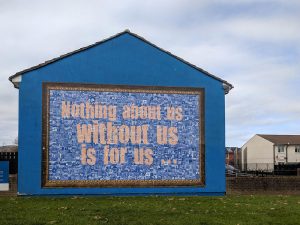Thinking back to his childhood working in the sugar beet fields of Washington, Arnoldo Garcia recalls the complexity of race, national origin, and immigration status in his own life. Garcia, who was born in the U.S., holds vivid memories of the INS harassing and deporting Mexican agricultural workers, regardless of their immigration status. “The difference between documented and undocumented doesn’t make much difference in a raid,” recalls Garcia, now a veteran immigrant rights activist. “It was all about your skin color and whether you could speak English like an ‘American.’”
Since most immigrants in the U.S. today are from the Third World, racism and anti-immigrant sentiment often combine in the way Garcia describes.
However, as activists, we struggle to link the distinct issues of race, national origin, and immigrant status, thus failing to acknowledge the many dimensions of experience of immigrants of color and to unite them with people of color born in the U.S.
“This stuff is really painful for me,” confesses Esmeralda Simmons, the director of the Center for Law and Social Justice in Brooklyn, whose parents emigrated from the Virgin Islands in search of the “American Dream.” “The U.S. lures black immigrants by telling them they’ll be welcomed, that they are different from African Americans, who refuse to ‘pull themselves up by their bootstraps’.” Simmons observes this superior attitude even among black immigrants who have “the lowest earnings and status, where it makes no sense in reality. But no one immigrates to the U.S. to become part of a racially oppressed group, so it takes long personal experience with racism for even black immigrants to see that they are viewed as ‘niggers’.”
For all our hard-fought alliances and hopes for unity, delving into the dynamics between immigrants and U.S.-born people of color remains a difficult and even risky proposition. These dynamics challenge us to make sense of extraordinary demographic and economic transformations, to bend our minds in new forms of analysis, and to face the delicate constructs that define our racial identity and positioning within the world.
Prior to World War I, most immigrants to the U.S. were white and European. Many faced powerful nativist discrimination but over time joined the melting pot of American whites. Sometimes they became vociferous racists themselves in the process, like the Irish in the Chinese exclusion movement. Climbing on the racist bandwagon became a sign of Americanization—for whites.
The 1965 immigration law drastically changed the color of immigration. This law, passed on the heels of the 1964 Civil Rights Act, ended four decades of immigration quotas favoring Western Europe and significantly increased legal immigration opportunities for people from Asia and Africa. The act also placed a cap (later modified) on legal migration from the Western Hemisphere, including Latin America and the Caribbean, which increased the undocumented portion of immigration within the Americas.
Contemporary immigration is massive. According to the 2000 Census, there are currently 28.4 million foreign-born residents in the United States, representing 10.4 percent of the total population, mostly from Central and South America, the Caribbean, and Asia. The Census numbers also show that immigration played a major role in pushing Latinos ahead of blacks as the largest minority in the country, and in producing a remarkable new level of national origin and immigration status diversity within the black population.
These are profound demographic changes. But their political impact remains far from certain. Immigrants of color clearly have the numbers to spark a strong racial justice movement. But do we have the consciousness and strategy to seize that opportunity?
The flow of immigrants since 1965 spurred the formation of organizations that sought to protect their rights. Focusing primarily on immigration policy, these groups led community-based campaigns to stop the Simpson-Mazzoli bill of the early ‘80s, and to oppose the punitive measures of the Immigration Reform and Control Act (IRCA) in 1986. With IRCA’s amnesty provisions, four million undocumented immigrants living in the United States became eligible to enter the years-long process of legalizing and potentially becoming citizens. Thus began the development of an immigrant rights infrastructure heavily based in helping immigrants to become legal and, for some organizations, continuing to fight to protect and expand the rights of those who are not.
Understandably, immigrant rights organizing has focused on those issues and institutions that make and enforce immigration law: the INS, the border patrol, employer sanctions, immigration policy, legalization, foreign relations, and language rights. This organizing has often remained isolated from fights for racial justice. Similarly, racial justice campaigns—such as exposing and remedying discrimination in housing, employment, education, law enforcement, insurance and bank redlining, and toxic dumping—focus on the principal institutions of racism, and have seldom incorporated demands for “immigrant rights”—even when centered in immigrant communities.
“The same immigrants who didn’t have papers in our communities also lived in substandard housing, were harassed by cops, and had kids in neglected schools. But we thought that fixing immigration status was someone else’s job. ‘That’s for the lawyers on the other side of town,’” observes Juan Leyton, a Chilean immigrant and long-time organizer in Roxbury, who now runs La Vida Urbana in Boston. “Looking back at it, we failed to account for the totality of our members’ experiences. They were discriminated against by racist housing policies, and were easily exploited by landlords because they didn’t have papers.”
Immigrant rights organizations were also trying to keep up with the explosion of amnesty applicants from the 1986 law, and received and spent resources running service programs to take advantage of the space that law created. Pancho Arguelles, an immigrant rights activist from Houston who now coordinates the National Organizers Alliance’s Immigrant Community Organizers Working Group, recalls: “We took a service approach to respond to the new situation. On the one hand, we had to meet the urgent needs of our base. But in adopting this approach, we built a dependency in treating folks as clients, rather than organizing them to become active in all the issues that affected them. We missed an opportunity to link their oppression as immigrants with their oppression as racial minorities in this country.”
The racial justice movement contributed to these divisions. One of the biggest splits between immigrant rights and racial justice occurred in 1986. Despite strong evidence that “employer sanctions” in the proposed Immigration Reform and Control Act (IRCA) would result in discrimination against anyone who appeared “foreign,” the National Association for the Advancement of Colored People (NAACP) supported those provisions, citing fear of African American worker displacement by immigrants. Although the NAACP later reversed this position, it had a widespread polarizing impact.
Several years later, when a federal government study found that employer sanctions had produced a widespread pattern and practice of discrimination, the Leadership Conference on Civil Rights ignored immigrant rights advocates and refused to take a position against the provisions.
Alfredo DeAvila, a former United Farm Workers organizer, recalls that union’s anti-immigrant policies in the 1960s and 1970s. “During the citrus strike in Yuma, Arizona, the UFW ran its own ‘wetline’—physically stopping undocumented immigrants, sometimes with violence.” While the UFW defended its position as protecting “American” workers’ jobs, DeAvila believes the situation had even deeper roots. “There was tremendous paranoia about immigration in the UFW,” argues DeAvila. “We Chicanos were scorned by Mexicans, yet we weren’t really ‘Americans’. Chicanos acted out their hang-ups by passing blame on immigrants.”
Sign up for our free newsletters
Subscribe to NPQ's newsletters to have our top stories delivered directly to your inbox.
By signing up, you agree to our privacy policy and terms of use, and to receive messages from NPQ and our partners.
In 1994 the dynamic tension between race and immigration played out in California. The political fight around Proposition 187 yielded important lessons in framing an immigrant rights issue in racial justice terms. Justice-minded Californians may have lost the election (Proposition 187 won by 62 percent), but their experience may help us win future fights.
The “Illegal Aliens” measure (as the official ballot summary named the initiative, which sought to deny health care, social services, and education to the undocumented) was not originally perceived in racial justice terms. With ads portraying Latinos rampaging across the U.S.-Mexico border, its proponents framed Prop. 187 as a “reasonable” remedy to curb illegal immigration from the south. The best-funded opposition to the measure, led by white liberal political consultants, tried to defend the positive role of immigrants in the economy and society.
In the early polling, no population group, not even those most likely to be negatively affected, opposed the measure. Latinos came the closest, with 48 percent opposing Prop. 187. Both Asian Americans and African Americans heavily favored the initiative. Over time, however, these numbers changed. On election day, 77 percent of Latinos voted against the measure and were joined by 53 percent of Asian Americans and African Americans. (By contrast, white voters didn’t budge, with about the same proportion—63 percent—favoring 187 all along.)
Grassroots campaigns to galvanize voters of color were largely credited with this electoral shift. By showing that Prop. 187 jeopardized the rights and well-being of all people of color, regardless of immigration status, organizers were able to greatly widen opposition to the initiative.
Progressives in both immigrant rights and racial justice are hoping that the current movement demanding legalization for undocumented immigrants will become an important terrain for linking race and immigration. “We need to develop some very specific anti-racist goals for legalization,” argues Esmeralda Simmons. Two years ago, Simmons helped engineer an important advance when the NY Black Census 2000 Coalition, led by three black non-immigrant members of Congress, announced its opposition to the use of census data by the INS to plan raids, and its support for new policies to legalize undocumented immigrants.
Without a strong racial justice analysis, legalization proponents may fall into the trap of framing new immigrants as “model minorities”: hard-working, two-parent, heterosexual families who have no need for government assistance. It’s the flip side of the “welfare queen” stereotype, intended to align the material interests of immigrants with existing racial ideologies. Simmons argues, “We need to raise the question, ‘Who will I become when I am naturalized and how is that feeding racism?’”
Others are watching to see whether and how organized labor will bring a racial justice consciousness to its booming new immigrant organizing. “Organized labor creates a valuable space for talking about the manipulation of workers through race and legal status,” asserts Katy Nunez-Adler, the former organizing director at the Service Employees International Union (SEIU) Local 1877 in Oakland, California, who helped lead the internal push for the AFL’s immigration policy reversal last February. “Workers really understand how employers try to divide them. It’s not difficult for people to see.” Nunez-Adler, a Jewish California native, believes labor must “take race issues on in a more direct and systematic way,” and be willing to confront taboo subjects such as economic competition between U.S.-born black workers and new immigrants. Nunez-Adler also challenges racial justice organizers to recognize the opportunity that labor presents. “There are 13.5 million union members in the United States. A real emphasis on cross-racial organizing and dialogue in labor could have big reverberations for the whole social justice movement.”
Welfare reauthorization, due in 2002, may also provide organizers with the opportunity for new connections between immigrant rights and racial justice. “The 1996 welfare reform law was a real wake-up call for immigrants to see that even people with a green card could be deported and lose benefits,” recalls Rini Chakraborty of the California Immigrant Welfare Collaborative. “Welfare issues offer immigrants a gateway to understanding oppression that is not based on immigration status.”
Chakraborty believes that welfare rights organizing on issues such as federal restoration of benefits, state access to food stamps, and language discrimination can build the link between national origin oppression and racial oppression by emphasizing that “the targets of the 1996 law were people of color. In its intent and its impact, the law was blatantly racist and anti-immigrant.”
Obviously, the gap between immigrant rights and racial justice offers the right a huge and powerful wedge. But the mutual self-interest doesn’t end there.
Without a well-developed racial justice consciousness and set of organizing strategies, immigrant rights could devolve into racist and ultimately self-defeating assimilationism. And without a strong global migration analysis, racial justice is likely to stagnate within a myopic and artificial domestic framework that neglects huge numbers of people of color.
Finally, all of us need to take a long, hard look at painful dynamics such as tension between U.S.-born and foreign-born people of African descent, racial hierarchies among Latinos, nationality distinctions among Asians, and legal immigrants’ hostility toward undocumented immigrants. Unless they are connected, immigrant rights and racial justice will stumble on their own internal contradictions, shattering the heart of our movements, our families, and our selves.
This article appeared originally in the Summer 2001 issue of ColorLines (www.colorlines.com), published by the Oakland-based Applied Research Center, a public policy, educational and research institute whose work emphasizes issues of race and social change.
Julie Quiroz-Martínez is the associate director of the Center for Third World Organizing in Oakland, California.











